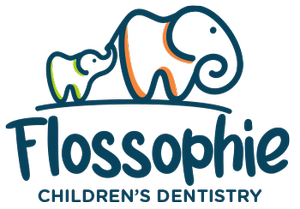Restorative Dentistry Near You
At Flossophie Children’s Dentistry, we understand that every smile is precious, especially for your child. That’s why we’re dedicated to providing brilliant restorative dentistry services tailored specifically for young smiles.
Our team of experienced pediatric dentists combines expertise with compassion to restore your child’s dental health and confidence, ensuring they can pridefully flash those pearly whites

What is Restorative Dentistry?
Restorative dentistry focuses on repairing and preserving the health and function of teeth damaged due to decay, trauma, or other factors. Maintaining optimal oral health is crucial for proper development and long-term well-being in children. Our restorative dentistry services aim to address issues early on, preventing further damage and promoting healthy smiles for life.
Pediatric dentistry
In pediatric dentistry, dental crowns serve as valuable treatment options for children with severely decayed, damaged, or weakened teeth. A dental crown is a tooth-shaped cap that is custom-made to fit over a compromised tooth, restoring its shape, strength, and function. These crowns are typically made of durable materials such as stainless steel or tooth-colored ceramic, ensuring durability and aesthetics. Dental crowns in pediatric dentistry not only provide structural support to weakened teeth but also protect them from further decay or fractures. They enable children to eat, speak, and smile with confidence while preserving the integrity of their primary or permanent teeth until they naturally exfoliate. With the help of dental crowns, pediatric dentists can effectively restore and safeguard children’s oral health, ensuring a comfortable and functional dentition throughout their developmental years.
Dental Fillings
Dental fillings play a vital role in pediatric dentistry, offering a reliable and minimally invasive solution for treating tooth decay in children. When a tooth develops a cavity, a dental filling is used to restore its form and function. Pediatric dentists typically opt for tooth-colored composite fillings that blend seamlessly with the natural tooth color, ensuring an aesthetically pleasing result. The process involves removing the decayed portion of the tooth, thoroughly cleaning the area, and filling it with the composite material. Dental fillings not only halt the progression of tooth decay but also provide structural support, preventing further damage to the affected tooth. By addressing cavities early on and utilizing dental fillings, pediatric dentists can preserve the health and integrity of children’s teeth, promoting a lifetime of optimal oral health.
Pulp Treatment
Pulp treatment is a crucial aspect of pediatric dentistry, specifically addressing dental problems that involve the pulp of a child’s tooth. The pulp is the soft, innermost part of the tooth containing blood vessels, nerves, and connective tissue. When the pulp becomes infected or damaged due to severe tooth decay or trauma, pulp treatment becomes necessary to preserve the affected tooth. The two main types of pulp treatment in pediatric dentistry are pulpotomy and pulpectomy. Pulpotomy involves the removal of the infected pulp tissue in the crown portion of the tooth while leaving the healthy pulp intact. Following the removal, a medicated material is placed to promote healing and protect the remaining pulp. In more severe cases, a pulpectomy may be required, which involves the complete removal of the infected pulp tissue from the crown and root canals of the tooth. After the pulpectomy, the canals are cleaned, shaped, and filled with a biocompatible material to prevent re-infection. Pulp treatment in pediatric dentistry is essential to alleviate pain, preserve the natural tooth structure, and maintain the overall oral health and well-being of children.
Silver Diamine Fluoride
Silver diamine fluoride (SDF) has emerged as a valuable tool in pediatric dentistry for the management of dental caries in children. SDF is a liquid solution containing silver particles and fluoride ions that can be applied topically to affected teeth. It offers a non-invasive and painless alternative for treating early-stage cavities, especially in young children or those with behavioral challenges. SDF works by arresting the progression of tooth decay, inhibiting the activity of harmful bacteria, and promoting the remineralization of weakened tooth structure. Furthermore, SDF can alleviate tooth sensitivity associated with cavities. Its application is straightforward and does not require drilling or anesthesia, making it well-suited for young patients. Although SDF stains the affected areas black, its effectiveness in halting caries and preventing further decay makes it a valuable adjunct in pediatric dentistry, particularly for managing dental caries in primary teeth and minimizing the need for more invasive treatments.
White Crowns
White crowns, also known as tooth-colored crowns or pediatric zirconia crowns, have become a popular treatment option in pediatric dentistry for restoring severely damaged or decayed primary teeth. These crowns are made from tooth-colored ceramic material, usually zirconia, which closely matches the appearance of natural teeth. White crowns offer several advantages for children, including superior aesthetics and durability. They provide a more esthetically pleasing result compared to traditional stainless-steel crowns, making them especially suitable for restoring front teeth. Additionally, white crowns are highly resistant to fracture and wear, ensuring longevity and functionality. Pediatric dentists can precisely shape and customize these crowns to fit the child’s tooth, preserving the natural bite and alignment. With their aesthetic appeal and strength, white crowns offer an excellent solution for pediatric patients, allowing them to maintain a confident smile while ensuring optimal oral health.
Minimally Invasive Dental
Minimally invasive dentistry has revolutionized pediatric dentistry by providing conservative and effective treatment approaches that prioritize the preservation of healthy tooth structure. This approach aims to minimize the removal of natural tooth material while effectively addressing dental issues in children. Minimally invasive techniques involve early detection and intervention, allowing for the timely management of dental caries and other oral conditions. With the use of advanced technologies and materials, such as laser dentistry, air abrasion, and adhesive dentistry, pediatric dentists can perform procedures with greater precision and minimal discomfort for young patients. Minimally invasive dentistry not only reduces the need for more invasive procedures but also promotes faster healing and reduces the potential for complications. By adopting a minimally invasive approach, pediatric dentists prioritize the long-term oral health and well-being of children while minimizing anxiety and promoting a positive dental experience.
Restorations (no drill approach)
Restorations with a no-drill approach have revolutionized pediatric dentistry by providing a minimally invasive and conservative alternative to traditional drilling procedures. This approach prioritizes preserving healthy tooth structure and minimizing discomfort for young patients. Instead of using a dental drill, advanced techniques such as air abrasion, laser dentistry, or minimally invasive adhesive procedures are employed to remove decay and prepare the tooth for restoration. The no-drill approach is especially beneficial for children who may be anxious or have a fear of dental drills. By utilizing these techniques, pediatric dentists can achieve effective restoration while maintaining the natural integrity of the tooth. The no-drill approach not only reduces the need for local anesthesia but also promotes faster healing and reduces the risk of complications. With its emphasis on minimally invasive techniques, restorations with a no-drill approach provide a child-friendly and comfortable experience, ensuring optimal oral health while instilling a positive attitude towards dental care.
Extractions
Extractions are a necessary aspect of pediatric dentistry when it comes to addressing certain dental conditions in children. While extractions may seem daunting, pediatric dentists employ strategies to ensure the process is as comfortable and stress-free as possible for young patients. Extractions may be required to remove severely decayed teeth, address overcrowding, or prepare for orthodontic treatment. Pediatric dentists take great care in explaining the procedure to the child and their parents, alleviating any fears or concerns. Local anesthesia is administered to ensure a painless experience during the extraction. In some cases, sedation or general anesthesia may be recommended to help children remain calm and comfortable throughout the procedure. Following extractions, pediatric dentists provide instructions on proper aftercare and discuss options for tooth replacement if necessary. By performing extractions with empathy and expertise, pediatric dentists ensure the overall oral health and well-being of children, setting the stage for a healthy and confident smile.
Space Maintainers
Space maintainers are crucial devices used in pediatric dentistry to preserve and guide the proper alignment of teeth following the premature loss of primary (baby) teeth. When a primary tooth is lost earlier than expected, space maintainers are custom-made appliances that hold the space open until the permanent tooth erupts. These devices prevent adjacent teeth from shifting into the open space, maintaining the appropriate spacing necessary for permanent teeth to come in correctly. Space maintainers can be fixed or removable, depending on the child’s specific needs. They are designed to be comfortable and discreet, ensuring that children can eat, speak, and play without hindrance. By utilizing space maintainers, pediatric dentists help prevent complications such as crowding, misalignment, and the need for more extensive orthodontic treatments in the future. These devices play a vital role in supporting the healthy development of the dentition, ensuring a proper bite and maintaining optimal oral health for children.
